Research projects †
Suported metallic nanoparticle catalysts
We are investigating the purification of CO gas by converting it to CO2, the production of aldehydes and acetic acid (raw materials for chemical products) from ethanol, and the production of gluconic acid (raw material for food) from glucose using metal nanoparticle-supported catalysts, which are composites of metal nanoparticles and ceramics. Gasoline and bioethanol are used as fuels for automobile engines, but gasoline emits toxic exhaust gases such as CO gas, so a high-performance catalyst is required to purify the exhaust gases. Bioethanol can also be used as fuel for automobiles, but in order to mass-produce the fuel and reduce its cost, it is required to use it for purposes other than automobile fuel, such as as a raw material for chemical products. If a manufacturing process for acetaldehyde and acetic acid using bioethanol as a raw material can be realized, it will be possible to produce acetaldehyde and acetic acid using biomass as a raw material without relying on petroleum resources, making it possible to realize a sustainable chemical process.

Flow simulation in a microchannel
We are developing an original program (C++ program) using the dissipative particle dynamics method (DPD method) to analyze the mixed state of solutions in microchannels. The DPD method is a type of coarse-grained molecular dynamics method that allows for large-scale calculations by treating a group of molecules that form the fluid or multiple atoms as a single particle. To perform fluid analysis using the DPD method, we developed an original program that can take into account friction between the wall and fluid, and confirmed that it is possible to analyze the mixed state of solutions in the channel. We are also developing a calculation program that can analyze the mixed state in a Y-shaped channel pattern.


- Otoha Ebine, Mao Hamamoto, Hiromasa Yagyu, "Channel Cross-sectional Shape Effect on Fluid Mixing Simulation using Dissipative Particle Dynamics with Wall Interaction", The 28th International Conference on Miniaturized Systems for Chemistry and Life Sciences (MicroTAS2024), Montreal (13-17 Oct. 2024), T066.d.
Application of metallic nanoparticles to labeling materals of antigen test
The red color produced by LSPR of gold nanoparticles (GNPs) is used to label antigen test drugs, but current test drugs cannot detect antigens when the antigen concentration is low. Our laboratory is investigating the application of triangular flat gold nanoplates (GNTs), which have stronger absorbance than GNPs, to label hCG antigen test drugs (pregnancy test drugs).



- Asahi Kimura, Mao Hamamoto, Hiromasa Yagyu: "Preparation of Citrate-stabilized Gold Nanotriangles for Labeling Materials of Lateral Flow Immunoassay", Japanese Journal of Applied Physics, Vol. 64, 03SP09.
- Asahi Kimura, Mao Hamamoto, Hiromasa Yagyu: "Preparation of citrate-stabilized gold nanotriangles for hCG Immunoassay", The 37th International Microprocesses and Nanotechnology Conference (MNC2024), Kyoto (12-15 Nov. 2024), 15P-1-66L.
- Asahi Kimura, Mao Hamamoto, Hiromasa Yagyu: "Immunochromatographic hCG Test Strips using Gold Nanotriangles", The 27th International Conference on Miniaturized Systems for Chemistry and Life Sciences (MicroTAS 2023), Katowice (15-19, October, 2023), T084.b.
- Asahi Kimura, Mao Hamamoto, Hiromasa Yagyu: "Preparation of Antibody Conjugated Gold Nanotriangles for Immunochromatographic Test", Proceedings of the Eurosensors XXXV, Lecce, Italy (10-13 September 2023), Proceedings 2024, 97, 120.
Evaluation of processing properties on micropowder blasting
Microblasting is a process that projects micro-sized ceramic projectiles onto a substrate with a mask, making it possible to machine fine grooves and holes with high aspect ratios. However, the mask material wears away during processing, so the machined shape depends on the wear resistance of the mask material. Our laboratory is investigating mask materials with excellent wear resistance and control of the machined shape by controlling the temperature of the mask material.



- Mikinari Takada, Mao Hamamoto, Hiromasa Yagyu: "Effect of a Photolithography Polymer Mask's Dynamic Viscoelasticity on Microchannel Cross-sectional Shapes of Glass Processed by Micropowder Blasting", Micromachines, Vol.15, 256 (2024).
- Hiromasa Yagyu, Koji Sugano, Shigehiko Hayashi, Osamu Tabata: "Micropowder Blasting using Nanoparticles Dispersed Polymer Mask for Rapid Prototyping of Glass Chip", Journal of Micromechanics and Microengineering, Vol.15 No.6, p.1236-1241 (2005).
- Hiromasa Yagyu, Shigehiko Hayashi, Osamu Tabata: "Application of Nanoparticles Dispersed Polymer to Micropowder Blasting Mask", Journal of Microelectromechanical Systems, Vol.13 No.1, p.1-6 (2004).
- Mikinari Takada, Mao Hamamoto, Hiromasa Yagyu: "Novel Microchannel Profile Control of Micropowder Blasting using Dynamic Viscoelasticity of Mask", Technical Digest of The 21st International Conference on Solid-State Sensors, Actuators and Microsystems (Transducers2021), Online (20-25 June 2021), pp.1166-1169.
- Mikinari Takada, Hiromasa Yagyu: "Micropowder Blasting with Mask Temperature Control for Microchannel Fabrication in Glass Microfluidics", Proceedings of 18th International Conference on Precision Engineering (ICPE2020), Kobe, Japan (23-27 November 2020), pp.409-410.
Synthesis of gold nanotriangles
Gold nanotriangles shows an absorption peak in a longer wavelength region in comparsion with spherical gols nanoparticles, and their application to labeling materials for antigen tests is attractetive atention due to this strong absorption. However, the preparation of gold nanotriangles is difficult, and it wa known that liquid-phase reduction can not be realized high reproductivity. In our laboratory, we have developed a simple synthesis method of gold nanotriangles with high reproductivity, and we study their application to chemical sensors and medical sensors.

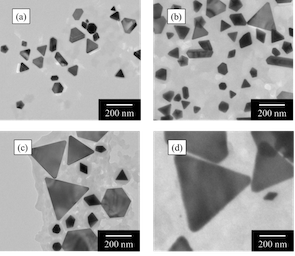
- Mao Hamamoto, Asahi Kimura, Hiromasa Yagyu: "Seedless and Non-thermal Liquid-phase Reduction Synthesis of Gold Nanotriangles", MRS Advances, Vol.8 Issue18, pp.1022-1027 (2023).
- Mao Hamamoto, Tomoki Yasu, Asahi Kimura, Haruki Toya, Hiromasa Yagyu: "Seedless One-pot Synthesis of Gold Nanotriangles by Non-thermal Liquid Phase Reduction Method", Proceedings of the 2022 MRS Fall Meeting, Boston & Online (6-8 December 2022), Boston & Online, NM05.16.01.
- Mao Hamamoto, Hiromasa Yagyu: "Seedless Synthesis of Gold Nanotriangles using Microfluidics with Non-thermal Liquid Phase Reduction", Proceedings of the 26th International Conference on Miniaturized Systems for Chemistry and Life Sciences (MicroTAS 2022), Hangzhou & Online (23-27 October 2022), pp.1227-1228.
Localized surface plasmon resonance sensors using gold nanoparticles
Gold nanoparticles has a strong absorption at a wavelength of around 530 nm by Localized surface plasmon resonance (LSPR).This absorption depends on particle size, size distribution, and dielectric constant of materials sorrounding nanoparticles. Since the dielectric constant is propotional to the square of the refractive index in visilbe light region, the refractive index of the solvent can be detected by measuring the absorption peak of gold nanoparticles immobilized on a glass substrate in solvents. Our laboratory is studying LSPR sensor to detect the refractive index of solvents using gold nanoparticles.

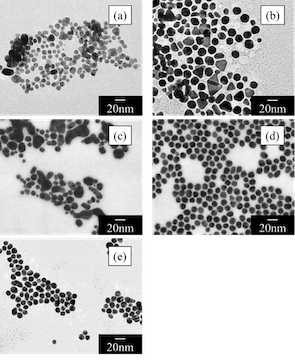

- Mao Hamamoto, Hiromasa Yagyu: "Particle Size Distribution and Au Concentration Dependence of the Refractive-Index Sensitivity of LSPR Sensors Based on Gold Nanoparticles", Journal of Nanoparticle Research, Vol.25,158 (2023).
- Mao Hamamoto, Hiromasa Yagyu: "Refractive Index Sensitivity of LSPR Sensor Using Gold Nanotriangles Synthesized by Seedless Non-Thermal Liquid-Phase Reduction", Proceedings of the Eurosensors XXXV, Lecce, Italy (10-13 September 2023), pp.1-2.
- Mao Hamamoto, Hiromasa Yagyu: "Size Distribution Dependence of Shape of LSPR Peak of Gold Nanoparticles", Proceedings of the 10th International Symposium on Materials Science and Surface Technology (MSST 2021), Yokohama, Japan & Online (21 February 2022), PA-04.
- Mao Hamamoto, Hiromasa Yagyu: "High Sensitive LSPR Sensor for Refractive Index of Solvent using Monodisperse Gold Nanoparticles", Proceedings of the 25th International Conference on Miniaturized Systems for Chemistry and Life Sciences (MicroTAS 2021), Palm Springs, USA & Online (10-14 October 2021), pp.1465-1466.
Synthesis of copper nanoparticles using microfluidic device
Copper nanoparticles (CuNPs) are attracting attention as ink materials with lower cost than silver and excellent in performance such as electrical conductivity. However, since copper is easily oxidized, synthesis in an inert atmosphere is necessary, and the particle size depends on the reduction temperature. It is expected that since the microfluidic device is sealed from the outside and the thermal efficiency is high, it is possible to control the particle size of CuNPs by changing the temperature and the flow rate in the microchannel.



- Yiyang Liang, Yoko Shinozaki, Hiromasa Yagyu: "Synthesis of Copper Nanoparticles using Glass Microfluidic Device", Proceedings of the Eurosensors XXXII, Graz, Austria (September, 2018), pp.1110-1114.
Synthesis of gold nanoparticles dispersion in organic solvent using microfluidic device
In the Brust-Siffrin method (Brust method), an immiscible solution consisting of an aqueous solution and a toluene solution is vigorously stirred in the presence of a protective agent after an aqueous gold ion solution is transferred to a toluene phase (organic phase) using a phase transfer catalyst, and then gold nanoparticles dispersion in toluene can be synthesized by adding an reducing agent solution. In the case of synthesizing nanoparticles by Brust method using a beaker, since the particle size depends on the addition rate of the reducing agent, the stirring speed, and the stirring time, it is difficult to control particle size. Since the flow state of immiscible solution in the microchannel depends on the flow rate, the particle size of the synthesized nanoparticles by adjusting the flow rate. In this study, we investigated the visualization of the flow state of the immiscible solution in the microchannel, and the relation of the flow rate and the coefficient of variation (standard deviation / mean diameter) was clarified.


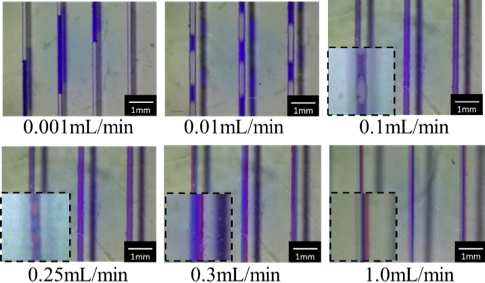
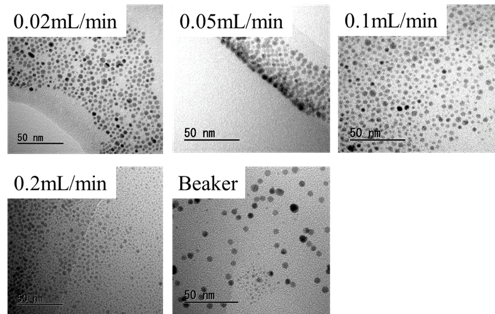
- Mao Hamamoto,Yiyang Liang, Hiromasa Yagyu: "Synthesis of Gold Nanoparticles Dispersion in Organic Solvent using Immiscible Fluid Flow in Microfluidics", IEEJ Transactions on Sensors and Micromachines (in Japanese) Vol. 139 No. 5, (2019), accepted.
- Mao Hamamoto, Yiyang Liang, Hiromasa Yagyu: "Size Control of Gold Nanoparticles in Organic Solvent using Immiscible Fluid Flow in Glass Microfluidics", Proceedings of the 22nd International Conferrence on Miniaturized Systems for Chemistry and Life Sciences (µTAS 2018), Kaohsiung, Taiwan (11-15 November, 2018), pp.2175-2177.
- Mao Hamamoto, Hiromasa Yagyu: "Two-Phase Brust-Schiffrin Synthesis of Gold Nanoparticles Dispersion in Organic Solvent on Glass Microfluidic Device", The 17th IEEE International Conference on Nanotechnology (IEEE NANO 2017), Pittsburgh (July 25-28, 2017), pp.632-635.
DNA nanostructure
The double stranded DNA model was created for production of DNA nanostructure applied DNA origami technology. The model with electrostatic interaction was discussed. We confirmed that the dependency of the salt concentration on the persistence length of the nCG-dsDNA model at the 30% charge is in good agreement with the Poisson–Boltzmann theoretical model.
- Hiromasa Yagyu, Do-Nyun Kim, Osamu Tabata: Proceedings of the 11th Annual IEEE International Conference on Nano/Micro Engineered and Molecular Systems (IEEE-NEMS 2016), Matsushima and Sendai (April, 2016), B3P-B-6.
- Hiromasa Yagyu, Jae-Young Lee, Do-Nyun Kim, Osamu Tabata: The Journal of Physical Chemistry B (American Chemical Society) , Vol. 121 Issue 19, p.5033-5039 (2017).
Laser microfabrication process
Laser microfabrication of goid nanoparticles dispersed polymer film is prposed. Since wave length of laser beam is selected an absorption wavelength by plasmon resonance vibration of gold nanoparticles, the polymer film can be micromachined. In this study, we focus the effect of size and distribution of naoparticle on laser processed shape.
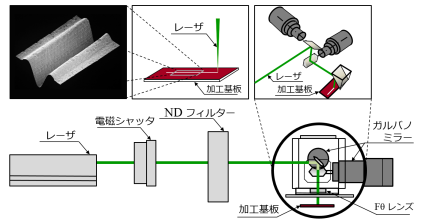


- H. Yagyu, O. Tabata: Applied Surface Science, Vol.255 No. 5 Part 1, p.2237-2243 (2008).
- T. Kikitsu, Y. Yagoto, M. Ogawa, H. Yagyu: The 18th International Conference on Solid-State Sensors, Actuators and Microsystems (Transducers2015), Anchorage (June, 2015), pp.1881-1884.
- H. Yagyu, T. Kikitsu: Journal of Micromechanics and Microengineering, Vol. 25 No. 12, 125018(7pp) (2015).
Analysis of gold nanoparticles synthesis mechanism using microfluidic device
A glass microfluidic device with mcirochannel is fabricated by micropowder blasting, and the prepareation of metalic nanoparticles on the produced device is prposed. In this study, we focus the production of device which can synthesize nanoparticles by liquid-phase reduction method.

- 濱村心, 森塚大樹, 柳生裕聖: 日本機械学会 第6回マイクロ・ナノ工学シンポジウム講演論文集, 松江(2014年10月), 20pm3-PM021.
- Yu Tanabe, Hiromasa Yagyu: Proceedings of SPIE Vol. 10061, 1006119 (2017).
- Yu Tanabe, Keisuke Yamauchi, Mao Hamamoto, Hiromasa Yagyu: International Symposium on Micro-Nano Science and Technology 2016, Tokyo (Dec. 16-18, 2016), p.124.
- Hiromasa Yagyu, Yu Tanabe, Satoru Takano, Mao Hamamoto: Micro & Nano Letters (The Institution of Engineering and Technology) , accepted.
- Mao Hamamoto, Hiromasa Yagyu: the 17th IEEE International Conference on Nanotechnology (IEEE NANO 2017), Pittsburgh (July, 2017), accepted.
Simulation of polymer resist for MEMS
The mechanical property of the polymer resist is required for development of MEMS microfluidic device. We predict the relationship between the mechanical property and the structure of resist in molecular scale by coarse grained molecular dynamics simulation.



- H. Yagyu, Y. Hirai, A. Uesugi, Y. Makino, K. Sugano, T. Tsuchiya, O. Tabata: Polymer, Vol.53, p.4834-4842 (2012).
- 平井義和, 柳生裕聖, 牧野圭秀, 上杉晃生, 菅野公二, 土屋智由, 田畑修: 電気学会論文誌E(センサ・マイクロマシン部門誌), Vol.133 No.9, p.320-329 (2013).
Simulation of rubber materials
A polymer chain is treated as a simple beads-spring model, and the viscoelastic and elongation behavier of the model is simulated using molecular dynamics calculation software such as OCTA/COGNAC and LAMMPS with supercomputer according to the model scale.



- H. Yagyu, T. Utsumi: Computational Materials Science, Vol.46 Issue 2, p.286-292 (2009).
- 柳生裕聖: 日本機械学会論文集(計算力学), Vol.80 No.810, p.CM0032 (2014).
- H. Yagyu: Soft Materials, Vol.13 Issue 4, p.263-270 (2015).
Simulation of micropowder blasting
We predict processed shape on a glass substrate by powder btasting using cellular automaton method. The simulator is improved by comparison of experimental result and simulated result, in addition of the production of processing system.

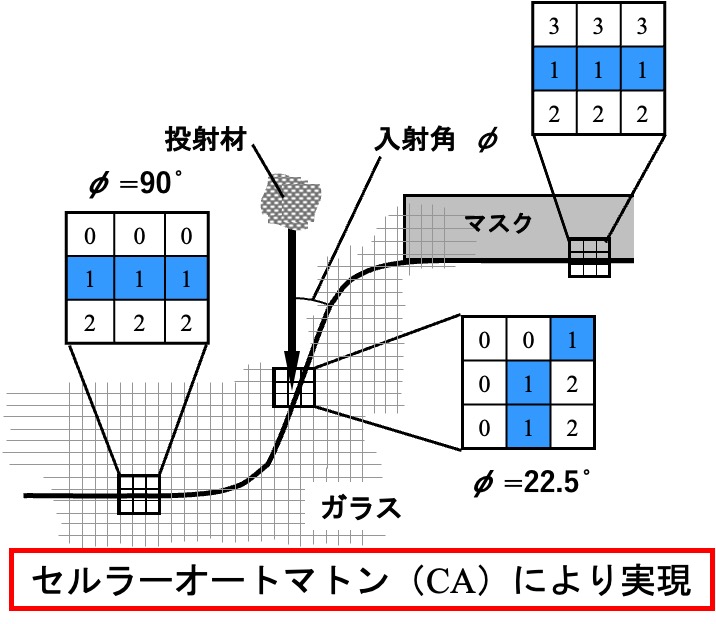

- H. Yagyu, O. Tabata: Journal of Micromechanics and Microengineering, Vol.18 No. 5, 055010(9pp) (2009).
- H. Yagyu, O. Tabata: Transaction on Electrical and Electronic Engineering, Vol.2 No. 3, p.348-356 (2007).
|
![[PukiWiki] [PukiWiki]]( image/title.gif)


